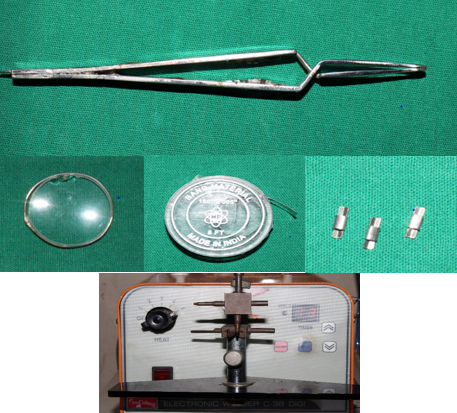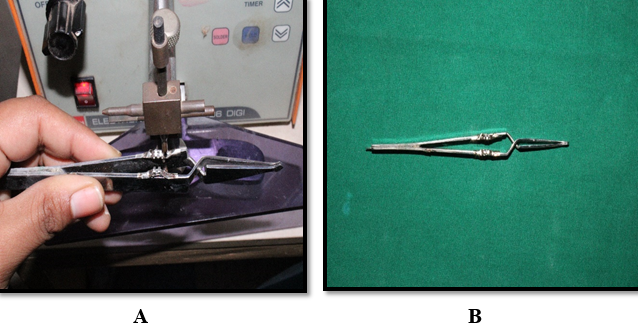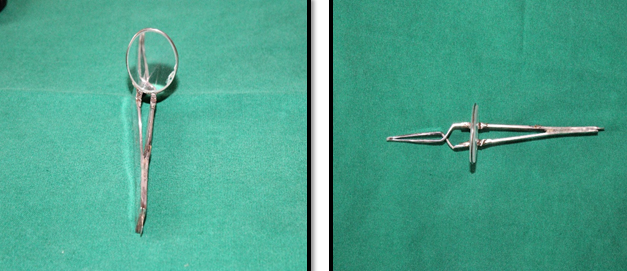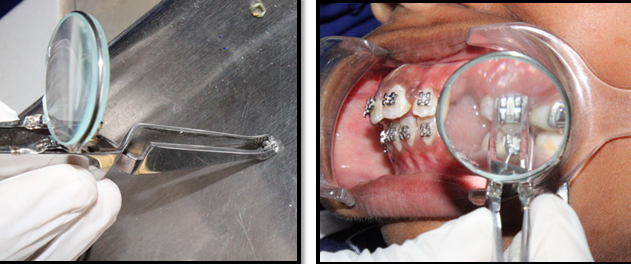- Visibility 67 Views
- Downloads 19 Downloads
- DOI 10.18231/j.jco.2023.013
-
CrossMark
- Citation
Modified bracket holder with magnifying lens: A precise bracket positioner
- Author Details:
-
Priya Balakrishnan *
-
Shashikumar Balasubramanyam
-
Praveen Kumar Prabhu
-
Roopak D Naik
Introduction
A well-finished orthodontic case has the proper alignment of crowns and roots and level marginal ridges. With pre-adjusted brackets (straight-wire appliances), the position of the bracket on the crown determines the tooth’s final tip, torque, height, and rotation. Poorly positioned brackets result in poorly positioned teeth and necessitate many more archwire adjustments. This can lead to an increase in treatment time or a final occlusion that is less than ideal.[1], [2], [3], [4], [5]
During the bonding procedure of placing the bracket, checking the position with the mouth mirror and then adjusting to the ideal position is time-consuming and the bracket displacement while repositioning might reduce the bond strength.
Therefore, to avoid these drawbacks, a modified bracket holder with magnifying lens will make the procedure simple and accurate. With precise visibility, the magnified image of the tooth surface allows orthodontists to place the bracket accurately according to tooth contour with respect to the mesiodistal and vertical position of the tooth. This magnifying lens which magnifies about 40X is detachable and autoclavable so it can be replaced when damaged.
Materials and Methods
Bracket holding tweezer
Magnifying lens
Palatal sheath
Band material
Spot welder


Methodology
Weld palatal sheath with band material.
Check the distance from the tooth surface to the lens for a precise magnifying effect and mark the position on the tweezer.
Weld the band material with the sheath to tweezer on the marked point.[[Figure 3] A]

Place the lens on welded sheaths of the tweezer. This allows the sliding of lens over the sheath so there will not be a hindrance during the opening and closing of tweezer [[Figure 4]].

Take the bracket with tweezer and place over tooth surface and position it precisely with help of magnifying lens. [[Figure 5]]

Conclusion
This instrument can be a greater advantage to our daily practice for better finishing of cases.
Advantages of instruments
Single instrument –ergonomic design.
Time saving.
Precise positioning of brackets.
Detachable magnifying lens – Replacable.
Economical.
Autoclavable.
Limitation of instrument
As the magnifying lens is attached to the bracket holding tweezer, the instrument compared to the normal tweezer instrument weighs more.
Repeated autoclaving of magnifying lenses cause damage to the lens so the new lens needs to be changed often.
Source of Funding
None.
Conflict of Interest
None.
References
- R P Mclaughlin, J C Bennett. Bracket placement with the preadjusted appliance. J Clin Orthod 1995. [Google Scholar]
- R H Samuels. A new bracket-positioning instrument. J Clin Orthod 2000. [Google Scholar]
- S K Carlson, Johnson E. Bracket positioning and resets: Five steps to align crowns and roots consistently. Am J Orthod Dentofacial Orthop 2001. [Google Scholar]
- D Armstrong, G Shen, P Petocz, M A Darendeliler. Accuracy of bracket placement by orthodontists and inexperienced dental students. Aust Orthod J 2007. [Google Scholar]
- A Manni, R Grassi, M Carbone. Customized bracket positioning with level marginal ridges. J Clin Orthod 2004. [Google Scholar]
How to Cite This Article
Vancouver
Balakrishnan P, Balasubramanyam S, Prabhu PK, Naik RD. Modified bracket holder with magnifying lens: A precise bracket positioner [Internet]. J Contemp Orthod. 2025 [cited 2025 Sep 06];7(1):74-76. Available from: https://doi.org/10.18231/j.jco.2023.013
APA
Balakrishnan, P., Balasubramanyam, S., Prabhu, P. K., Naik, R. D. (2025). Modified bracket holder with magnifying lens: A precise bracket positioner. J Contemp Orthod, 7(1), 74-76. https://doi.org/10.18231/j.jco.2023.013
MLA
Balakrishnan, Priya, Balasubramanyam, Shashikumar, Prabhu, Praveen Kumar, Naik, Roopak D. "Modified bracket holder with magnifying lens: A precise bracket positioner." J Contemp Orthod, vol. 7, no. 1, 2025, pp. 74-76. https://doi.org/10.18231/j.jco.2023.013
Chicago
Balakrishnan, P., Balasubramanyam, S., Prabhu, P. K., Naik, R. D.. "Modified bracket holder with magnifying lens: A precise bracket positioner." J Contemp Orthod 7, no. 1 (2025): 74-76. https://doi.org/10.18231/j.jco.2023.013
